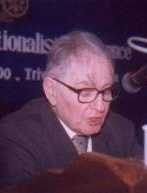- Some Critiques of the Big Bang Cosmology (1997) [Updated 7 years ago]
- In Memoriam Toivo Jaakkola (11 March 1941 - 24 May 1995) (1996) [Updated 1 decade ago]
- Spatial Fluctuation of the Hubble "Constant" (1990) [Updated 1 decade ago]
- A Possible Tired-Light Mechanism (1988) [Updated 1 decade ago]
- How to Describe Physical Reality? (1988) [Updated 1 decade ago]
- Some Critiques of the Big Bang Cosmology (1997) [Updated 7 years ago]
Still more shocking than the metaphysical assumption of some initial singularity, is the constant insistence upon the so-called cosmological principle of ?homogeneity? and ?isotropy? of the Universe. Observations do contradict this principle. And to me, the inhomogeneous, fractal at least on a certain scale range, of the distribution of matter is in itself an important cosmological fact, hitherto almost neglected. Moreover difficultties as to the applicability of the second principle of thermodynamics, observations of abnormal redshifts, etc., are casting large doubts not only upon the standard cosmological models, but even on the interpretation of the observed redshift as due solely to a universal expansion.
- In Memoriam Toivo Jaakkola (11 March 1941 - 24 May 1995) (1996) [Updated 1 decade ago]
Dying so young, at 54 years of age, is in itself a sad and painful thing. But when one is, as Toivo Jaakkola was, in a period of full productivity, of continuous creative imagination, it is for all his friends and colleagues an almost intolerable loss.
- Spatial Fluctuation of the Hubble "Constant" (1990) [Updated 1 decade ago]
Six samples of objects have been analyzed in order to check whether the redshift asymmetry discovered by Rubin et al. is a general effect. The results for all samples are consistent with the existence of the asymmetry. Its average magnitude is = 1300 + 210 km/s. The asymmetry vanishes at large distances. Various interpretations of the effect have been discussed. Arguments are given in favour of a non-Doppler redshift occurring in the intergalactic space within the Local Supergalaxy and other concentrations of galaxies.
This article was written in 1975, and has remained unpublished until now. It is published here in the hope that it will stimulate fresh thinking on the controversial issue of non-velocity "cosmological" redshifts.
- A Possible Tired-Light Mechanism (1988) [Updated 1 decade ago]
Recent developments in physics and astrophysics lead us to introduce a new tired-light mechanism involving an interaction between a massive photon and Dirac's vacuum particles.
Tired-light mechanisms appeared in the literature as early as the late twenties, when Zwicky (1929), disturbed by the large values of the apparent recession velocities of galaxies, conceived a mechanism whereby photons could lose energy through an interaction with the medium located between the source and the observer. Rather than enter into a detailed historical review of these attempts, we will simply remind the reader that we have suggested other such mechanisms, beginning in 1971. The first idea we put forward (following an original idea by Finlay-Freundlich, 1953-1954, with the approval of Max Born, 1954 a and b) was a photon-photon interaction. This mechanism (Pecker, 1974) was difficult to accept, and we looked instead for possible interactions between the photon and some massive pseudoscalar boson.
- How to Describe Physical Reality? (1988) [Updated 1 decade ago]
Because cosmology touches our ideas about what lies "beyond" as much as about what went "before," it will always raise controversy and even cause bitterness. Although I am a classical astrophysicist, I reckon that even in the solar spectrum, some elements indicate some general principle of the universe. At the same time, another universe than that of the astrophysicists is offered by mathematicians who conceive all sorts of objects and geometries. But there is too great a temptation to consider these constructions "real," as soon as they are plausible.



